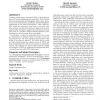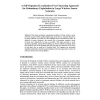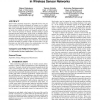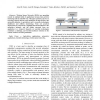ITICSE
2010
ACM
13 years 11 months ago
2010
ACM
Teaching wireless sensor networks (WSNs) at the undergraduate level is both challenging and rewarding. WSNs include low-level programming and debugging, power-aware operations, no...
CEC
2010
IEEE
13 years 11 months ago
2010
IEEE
Abstract— Mobile agents are often used in wireless sensor networks for distributed target detection with the goal of minimizing the transmission of non-critical data that negativ...
GLOBECOM
2008
IEEE
14 years 16 days ago
2008
IEEE
— Wireless sensor networks span from military applications into everyday life. Body sensor networks greatly benefit from wireless sensor networks to answer the biofeedback challe...
GISCIENCE
2008
Springer
14 years 16 days ago
2008
Springer
Dynamic geographic phenomena, such as forest fires and oil spills, can have dire environmental, sociopolitical, and economic consequences. Mitigating, if not preventing such events...
GISCIENCE
2008
Springer
14 years 16 days ago
2008
Springer
Movement patterns, like flocking and converging, leading and following, are examples of high-level process knowledge derived from lowlevel trajectory data. Conventional techniques...
GI
2008
Springer
14 years 16 days ago
2008
Springer
: This paper investigates organization problems of large wireless sensor networks. In spite of their random deployment, nodes have to organize themselves as energy efficient as pos...
HPCC
2010
Springer
14 years 17 days ago
2010
Springer
This paper investigates the energy cost of control packets in schedule-based medium access control protocols in wireless sensor networks. Control packets can be useful not only to ...
DAIS
2009
14 years 17 days ago
2009
Abstract. Applications for Wireless Sensor Networks (WSNs) are being spread to areas in which the contextual parameters modeling the environment are changing over the application l...
DMSN
2010
ACM
14 years 17 days ago
2010
ACM
Sensor nodes constitute inexpensive, disposable devices that are often scattered in harsh environments of interest so as to collect and communicate desired measurements of monitor...
WCE
2007
14 years 19 days ago
2007
— Wireless Sensor Networks (WSNs) are spreading around in multiple fields of applications because they perform measuring tasks in a flexible way. This paper presents a survey on ...




